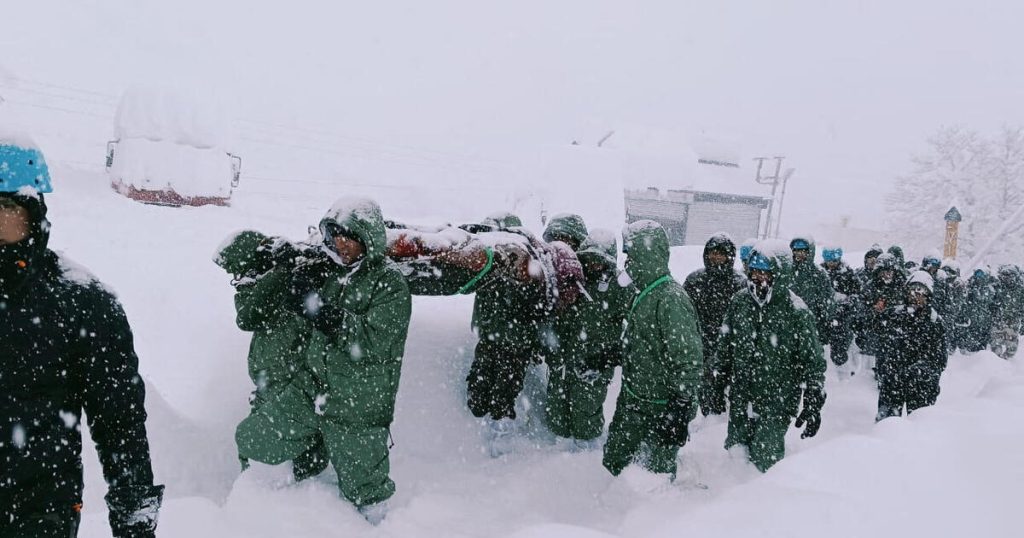In a tragic incident in Uttarakhand, India, over 40 construction workers are currently unaccounted for following a devastating avalanche that struck a construction camp on Friday. The avalanche, triggered by severe weather conditions marked by heavy snowfall and strong winds, has impeded rescue efforts, leading to concerns for the safety of those buried beneath the snow. As rescue operations continue, officials emphasize the impact of extreme weather on vulnerable regions in the Himalayas, underscoring the need for heightened awareness and preventive measures against such disasters.
| Article Subheadings |
|---|
| 1) Overview of the Avalanche Incident |
| 2) Current Status of Rescue Operations |
| 3) Government and Local Response |
| 4) Climate Change Implications |
| 5) Historical Context of Natural Disasters in the Region |
Overview of the Avalanche Incident
On Friday, in the Chamoli district of Uttarakhand, a significant avalanche occurred at a construction camp, burying numerous workers under layers of snow and debris. Reports indicate that more than 40 workers are missing, with only 15 confirmed safe as rescue teams mobilize in response to the crisis. The avalanche struck amid an ongoing winter storm characterized by heavy snowfall and strong winds that have been affecting the region for several days. The environmental conditions have created treacherous landscapes, making it increasingly challenging for workers in the area.
Current Status of Rescue Operations
Rescue operations are currently underway, although they face significant hurdles due to adverse weather conditions. Deepam Seth, the state’s director general of police, highlighted the difficulties posed by the inclement weather, stating, “It has been snowing with strong winds… The roads are completely blocked.” These conditions have necessitated the deployment of snow cutters to clear pathways, attempting to facilitate access for rescue personnel and equipment. Search and rescue teams, comprised of trained professionals and volunteers, have been tirelessly working to locate the missing workers, digging through heavy snow in hopes of finding survivors.
Government and Local Response
In light of this tragic event, Uttarakhand Chief Minister Pushkar Singh Dhami expressed his deep sorrow over the incident and confirmed that he is personally monitoring the rescue operations. The government aims to mobilize every available resource to ensure the safety of those trapped and to expedite rescue efforts. The local disaster management authorities are collaborating with various agencies to coordinate the operation effectively. Their commitment reflects a widespread recognition of the urgency surrounding rescue missions in winter storms, particularly in regions susceptible to such disasters.
Climate Change Implications
Experts have voiced concerns regarding the impact of climate change on the frequency and severity of extreme weather events, including avalanches. Observations indicate that rising global temperatures, a direct result of human activities such as fossil fuel combustion, are contributing to more severe winter weather patterns. These processes are accelerating snowmelt in the Himalayas and altering traditional climate models. The recent surge in extreme weather patterns in the region illustrates the pressing need for comprehensive climate action to mitigate future risks associated with such disasters.
Historical Context of Natural Disasters in the Region
Uttarakhand has a history of devastating natural disasters, characterized by a rise in frequency and scale due to various factors, including accelerated development and environmental degradation. Past tragedies, such as the catastrophic floods in 2013 that claimed around 6,000 lives and a significant glacier-related incident in 2021 that resulted in nearly 100 deaths, have raised alarms among environmentalists and policymakers. These events have sparked debates and calls for stricter regulations on development projects in ecologically sensitive areas, emphasizing the necessity to review human intervention in fragile ecosystems.
| No. | Key Points |
|---|---|
| 1 | Over 40 construction workers are missing following an avalanche in Chamoli, Uttarakhand. |
| 2 | Rescue operations face challenges due to adverse weather conditions including heavy snowfall and blocked roads. |
| 3 | The Chief Minister of Uttarakhand is overseeing rescue efforts as the government mobilizes resources. |
| 4 | Experts emphasize the connection between climate change and extreme weather events like avalanches. |
| 5 | Uttarakhand’s history of natural disasters raises awareness regarding development activities in sensitive regions. |
Summary
The avalanche incident in Uttarakhand highlights the dangerous interplay between construction activities in fragile ecosystems and the increasing frequency of extreme weather events attributed to climate change. With rescue efforts currently hampered by severe weather, the tragedy serves as a stark reminder of the risks faced by workers in the region. As authorities respond to this immediate crisis, the broader implications of climate change and the need for responsible development practices loom large. This incident calls not only for urgent action to locate the missing workers but also for a rigorous reassessment of human activities in the Himalayas.
Frequently Asked Questions
Question: What steps are being taken to locate the missing workers?
Rescue teams have been deployed to search for the missing workers, utilizing snow cutters to clear roads and improve access to the affected area. Efforts are hindered by ongoing adverse weather, but authorities are committed to locating those trapped.
Question: How does climate change affect avalanches?
Climate change contributes to warmer temperatures and more severe weather patterns, leading to increased volatility in snow and ice conditions in mountainous regions, which can heighten the likelihood of avalanches.
Question: What historical events have influenced disaster preparedness in Uttarakhand?
Uttarakhand’s history includes major disasters like the 2013 floods and the 2021 glacier incident, prompting calls for improved regulations on construction and development in ecologically vulnerable areas.


